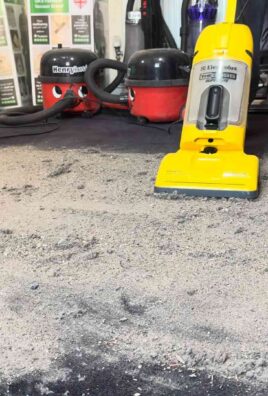Quick kitchen deep cleaning tips are a game-changer, trust me! I know, I know, the words “deep cleaning” and “kitchen” in the same sentence can send shivers down your spine. But what if I told you that you could achieve a sparkling, germ-free kitchen without dedicating an entire weekend to the task?
For generations, a clean kitchen has been the heart of the home, a place where families gather, meals are prepared with love, and memories are made. Think back to your grandmother’s kitchen – always spotless, always inviting. While she might have spent hours scrubbing, we’ve got some clever shortcuts to achieve the same results in a fraction of the time.
Let’s face it, life is busy! We’re all juggling work, family, and everything in between. The last thing anyone wants is to spend their precious free time battling stubborn grease and grime. That’s where these quick kitchen deep cleaning tips come in. They’re designed to be efficient, effective, and easy to incorporate into your regular routine. Imagine having a kitchen that’s not only clean but also a joy to be in. No more cringing at the sight of sticky countertops or dreading opening the refrigerator. With these simple hacks, you can reclaim your kitchen and enjoy a healthier, happier home. So, grab your cleaning supplies, and let’s get started!

DIY Deep Clean Your Kitchen Like a Pro (Without Breaking the Bank!)
Okay, let’s face it, the kitchen. It’s the heart of the home, but also the battlefield of crumbs, splatters, and mysterious sticky substances. A quick wipe-down is fine for daily maintenance, but sometimes, you just need to roll up your sleeves and *really* deep clean. Don’t worry, I’m here to guide you through it! We’ll tackle everything from the greasy stovetop to the lurking dust bunnies under the fridge. Get ready to transform your kitchen from “meh” to “marvelous!”
Gather Your Arsenal (aka Cleaning Supplies)
Before we dive in, let’s make sure we have everything we need. Trust me, having all your supplies ready will save you tons of time and frustration.
* All-Purpose Cleaner: A good all-purpose cleaner is your best friend for most surfaces. I personally love using a diluted vinegar solution (equal parts white vinegar and water) for its eco-friendliness and effectiveness.
* Dish Soap: Essential for washing dishes, but also surprisingly useful for cleaning greasy surfaces.
* Baking Soda: This is a natural abrasive that’s great for scrubbing without scratching.
* White Vinegar: As mentioned above, vinegar is a cleaning powerhouse!
* Microfiber Cloths: These are amazing for wiping down surfaces without leaving streaks or lint. Stock up!
* Scrub Brush: For tackling stubborn grime.
* Old Toothbrush: Perfect for getting into those hard-to-reach crevices.
* Rubber Gloves: Protect your hands from harsh chemicals and hot water.
* Trash Bags: For disposing of all the gunk we’re about to uncover.
* Sponge: A good old-fashioned sponge is always handy.
* Paper Towels: For quick cleanups and drying.
* Oven Cleaner (Optional): If your oven is particularly grimy, you might need a dedicated oven cleaner. Choose one that suits your oven type (self-cleaning or not).
* Glass Cleaner: For sparkling windows and mirrors.
* Vacuum Cleaner with attachments: For getting into corners and under appliances.
* Screwdriver: You might need this to remove vent covers or appliance parts for cleaning.
Phase 1: Declutter and Prep
Before we start scrubbing, we need to clear the decks! This will make the cleaning process much easier and more efficient.
1. Clear the Counters: Remove everything from your countertops – appliances, utensils, spice racks, everything! This will give you a clear surface to work with.
2. Empty the Sink: Wash any dishes that are lurking in the sink. A clean sink is a happy sink!
3. Take Out the Trash: Empty all trash cans and replace the liners.
4. Clear the Table: Remove anything from the kitchen table.
5. Gather Your Cleaning Supplies: Have all your cleaning supplies within easy reach.
Phase 2: Tackling the Appliances
Now, let’s get to the heart of the kitchen – the appliances!
Cleaning the Oven
This is often the most dreaded task, but it doesn’t have to be a nightmare.
1. Self-Cleaning Oven: If you have a self-cleaning oven, run the self-cleaning cycle according to the manufacturer’s instructions. Be sure to remove the racks beforehand.
2. Non-Self-Cleaning Oven (Baking Soda Method):
* Step 1: Remove the oven racks and soak them in hot, soapy water.
* Step 2: Make a paste of baking soda and water (about 1/2 cup baking soda and a few tablespoons of water).
* Step 3: Spread the paste all over the inside of the oven, avoiding the heating elements.
* Step 4: Let the paste sit overnight (or for at least 12 hours).
* Step 5: The next day, wipe out the baking soda paste with a damp cloth. You might need to use a scraper for stubborn spots.
* Step 6: Spray the inside of the oven with white vinegar. This will react with any remaining baking soda and help loosen any remaining grime.
* Step 7: Wipe the oven clean with a damp cloth.
* Step 8: Wash the oven racks and dry them thoroughly before replacing them.
3. Non-Self-Cleaning Oven (Oven Cleaner Method):
* Step 1: Follow the instructions on your oven cleaner carefully. Be sure to wear gloves and eye protection.
* Step 2: Most oven cleaners require you to spray the cleaner inside the oven and let it sit for a specified amount of time.
* Step 3: Wipe the oven clean with a damp cloth. You might need to rinse it several times to remove all traces of the cleaner.
* Step 4: Wash the oven racks and dry them thoroughly before replacing them.
Cleaning the Stovetop
Whether you have a gas or electric stovetop, keeping it clean is essential.
1. Gas Stovetop:
* Step 1: Remove the grates and burner caps.
* Step 2: Soak the grates and burner caps in hot, soapy water.
* Step 3: Use a scrub brush to remove any baked-on food.
* Step 4: Rinse the grates and burner caps thoroughly and dry them before replacing them.
* Step 5: Wipe down the stovetop surface with an all-purpose cleaner. Use a scraper for stubborn spots.
* Step 6: Use an old toothbrush to clean around the burners.
2. Electric Stovetop:
* Step 1: Make sure the stovetop is cool.
* Step 2: Wipe down the stovetop surface with an all-purpose cleaner.
* Step 3: For stubborn spots, make a paste of baking soda and water and apply it to the affected area. Let it sit for a few minutes, then scrub with a non-abrasive sponge.
* Step 4: Rinse the stovetop with a damp cloth and dry it thoroughly.
Cleaning the Microwave
This is a quick and easy task that can make a big difference.
1. Steam Cleaning Method:
* Step 1: Fill a microwave-safe bowl with 1 cup of water and a few tablespoons of white vinegar or lemon juice.
* Step 2: Microwave the mixture on high for 5 minutes.
* Step 3: Let the mixture sit in the microwave for another 5 minutes (without opening the door). The steam will loosen any splatters and grime.
* Step 4: Carefully remove the bowl and wipe down the inside of the microwave with a damp cloth.
2. Alternative Method:
* Step 1: Wipe down the inside of the microwave with a damp sponge and a mild dish soap solution.
* Step 2: Rinse the microwave with a clean, damp cloth.
* Step 3: Dry the microwave thoroughly.
Cleaning the Refrigerator
A clean refrigerator is a happy refrigerator (and a healthier one!).
1. Empty the Refrigerator: Remove all food items from the refrigerator. Discard any expired or spoiled food.
2. Remove Shelves and Drawers: Remove all shelves and drawers from the refrigerator.
3. Wash Shelves and Drawers: Wash the shelves and drawers in hot, soapy water. Rinse them thoroughly and dry them before replacing them.
4. Wipe Down the Interior: Wipe down the interior of the refrigerator with an all-purpose cleaner. Pay special attention to spills and stains.
5. Clean the Door Seals: Clean the door seals with a damp cloth and a mild dish soap solution.
6. Replace Shelves and Drawers: Replace the shelves and drawers in the refrigerator.
7. Restock the Refrigerator: Restock the refrigerator with your food items.
Cleaning the Dishwasher
Yes, even the dishwasher needs cleaning!
1. Remove Food Debris: Remove any food debris from the bottom of the dishwasher.
2. Clean the Filter: Remove the filter and clean it thoroughly with hot, soapy water.
3. Run a Cleaning Cycle: Run a cleaning cycle with a dishwasher cleaner or a cup of white vinegar.
4. Wipe Down the Exterior: Wipe down the exterior of the dishwasher with an all-purpose cleaner.
Phase 3: Conquering the Surfaces
Now that the appliances

Conclusion
So, there you have it! Transforming your kitchen from a chaotic culinary space to a sparkling sanctuary doesn’t require expensive cleaning services or harsh chemicals. This DIY deep cleaning trick, focusing on a blend of readily available ingredients and a systematic approach, is a game-changer for anyone looking to revitalize their kitchen. We’ve shown you how to tackle the grime, grease, and lingering odors that accumulate over time, leaving you with a kitchen that’s not only visually appealing but also hygienically sound.
Why is this DIY approach a must-try? Because it’s effective, economical, and environmentally conscious. You’re bypassing the need for potentially harmful commercial cleaners, saving money, and reducing your environmental footprint all in one go. Plus, there’s a certain satisfaction that comes from knowing you’ve achieved a deep clean using your own ingenuity and elbow grease.
But the beauty of this DIY deep cleaning trick lies in its adaptability. Feel free to experiment with variations to suit your specific needs and preferences. For instance, if you’re dealing with particularly stubborn grease stains on your stovetop, consider adding a paste of baking soda and water to the affected areas before scrubbing. For a more fragrant clean, infuse your cleaning solution with a few drops of your favorite essential oils, such as lemon, lavender, or tea tree oil, known for their antibacterial properties. If you have stainless steel appliances, remember to wipe them down with a microfiber cloth in the direction of the grain to prevent streaks.
Don’t be afraid to adjust the ratios of ingredients based on the severity of the grime you’re tackling. A heavily soiled oven might require a more concentrated cleaning solution, while a lightly used countertop might only need a gentle wipe-down. The key is to observe, adapt, and refine your approach until you achieve the desired results.
Remember, consistency is key. While this DIY deep cleaning trick is incredibly effective, it’s not a one-time fix. Incorporating it into your regular cleaning routine will help prevent the buildup of grime and keep your kitchen looking its best. Aim to perform a deep clean at least once a month, or more frequently if you cook regularly.
We are confident that this DIY deep cleaning trick will revolutionize your kitchen cleaning routine. It’s a simple, effective, and affordable way to achieve a sparkling clean kitchen without the use of harsh chemicals. So, ditch the expensive cleaners and embrace the power of DIY!
Now, we want to hear from you! Give this DIY deep cleaning trick a try and share your experience with us. What variations did you try? What challenges did you encounter? What tips and tricks did you discover along the way? Your feedback will not only help us improve this guide but also inspire others to embrace the power of DIY cleaning. Share your photos and stories on social media using #DIYKitchenClean and let’s create a community of sparkling clean kitchens! We can’t wait to see your results!
FAQ
Frequently Asked Questions About DIY Kitchen Deep Cleaning
1. What are the key ingredients needed for this DIY kitchen deep cleaning trick?
The core ingredients typically include baking soda, white vinegar, dish soap, and water. Lemon juice can also be a great addition for its degreasing and deodorizing properties. The exact ratios will depend on the specific cleaning task, but these are the staples you’ll want to have on hand. For example, a paste of baking soda and water is excellent for scrubbing stubborn stains, while a solution of vinegar and water is perfect for cleaning countertops and appliances.
2. Is this DIY cleaning method safe for all kitchen surfaces?
While generally safe, it’s always a good idea to test the cleaning solution on a small, inconspicuous area first, especially on delicate surfaces like natural stone countertops or painted cabinets. Avoid using abrasive scrubbers on easily scratched surfaces. Vinegar, while a powerful cleaner, can be acidic and may damage certain materials over time. Dilution is key! For surfaces like granite or marble, a gentler solution of dish soap and water is often preferred.
3. How often should I perform a deep clean of my kitchen?
Ideally, a deep clean should be performed at least once a month. However, the frequency may vary depending on how often you cook and the level of mess generated. If you cook frequently, you might consider deep cleaning every two weeks. Regular maintenance, such as wiping down countertops and sweeping floors daily, can help extend the time between deep cleans.
4. What’s the best way to tackle stubborn grease stains on my stovetop?
For stubborn grease stains, create a paste of baking soda and water. Apply the paste to the affected area, let it sit for at least 30 minutes (or even overnight for really tough stains), and then scrub with a non-abrasive sponge or cloth. You can also add a few drops of dish soap to the paste for extra cleaning power. Another effective method is to use a solution of vinegar and hot water. Spray the solution onto the grease stains, let it sit for a few minutes, and then wipe clean.
5. How can I eliminate lingering odors in my kitchen?
Baking soda is a natural odor absorber. Place an open box of baking soda in your refrigerator and another in your pantry to help neutralize odors. You can also simmer a pot of water with lemon slices, orange peels, or cinnamon sticks to freshen the air. For persistent odors, try placing a bowl of white vinegar in the kitchen overnight. Ensure proper ventilation by opening windows and running the exhaust fan while cooking.
6. What are some eco-friendly alternatives to commercial cleaning products?
This entire DIY approach is an eco-friendly alternative! Beyond the core ingredients, consider using reusable microfiber cloths instead of paper towels. You can also make your own all-purpose cleaner by combining water, vinegar, and a few drops of essential oils. Look for dish soaps and other cleaning products that are labeled as biodegradable and free of harsh chemicals.
7. How do I clean my oven using this DIY method?
For oven cleaning, create a paste of baking soda and water. Remove the oven racks and spread the paste evenly throughout the interior of the oven, avoiding the heating elements. Let the paste sit overnight. The next day, wipe away the paste with a damp cloth. For stubborn residue, spray with vinegar and scrub again. This method is much gentler than using harsh oven cleaners.
8. Can I use this DIY cleaning method on my stainless steel appliances?
Yes, but with caution. Always wipe stainless steel appliances in the direction of the grain to prevent streaks. A solution of vinegar and water can be used to clean stainless steel, but be sure to dilute it properly. You can also use a specialized stainless steel cleaner or a mixture of olive oil and lemon juice to polish and protect the surface.
9. What’s the best way to clean my kitchen sink?
For stainless steel sinks, sprinkle baking soda into the sink and scrub with a damp sponge. Rinse thoroughly. For porcelain sinks, use a non-abrasive cleaner to avoid scratching the surface. You can also use a solution of vinegar and water to remove water spots and stains. To disinfect the sink, pour a small amount of bleach down the drain and let it sit for a few minutes before flushing with water.
10. How can I get my kitchen floors sparkling clean?
The best method depends on the type of flooring you have. For tile floors, a solution of vinegar and water is generally effective. For hardwood floors, use a cleaner specifically designed for hardwood and avoid using too much water. For laminate floors, use a damp mop and a mild detergent. Always sweep or vacuum the floors before mopping to remove loose dirt and debris.
11. What essential oils are best for kitchen cleaning and why?
Lemon essential oil is a popular choice due to its degreasing and antibacterial properties, leaving a fresh, citrusy scent. Tea tree oil is another excellent antibacterial and antifungal option, ideal for disinfecting surfaces. Lavender oil offers a calming aroma while still providing cleaning benefits. Eucalyptus oil is known for its antiseptic properties and can help freshen the air. Always dilute essential oils properly before using them on surfaces.
12. How can I prevent grime buildup in my kitchen in the first place?
Prevention is key! Wipe down countertops and stovetops after each use. Regularly clean your microwave and oven to prevent food splatters from hardening. Empty the trash can frequently to avoid odors. Keep your sink clean and dry to prevent water spots and mildew. By incorporating these simple habits into your daily routine, you can significantly reduce the amount of grime that accumulates in your kitchen.





Leave a Comment